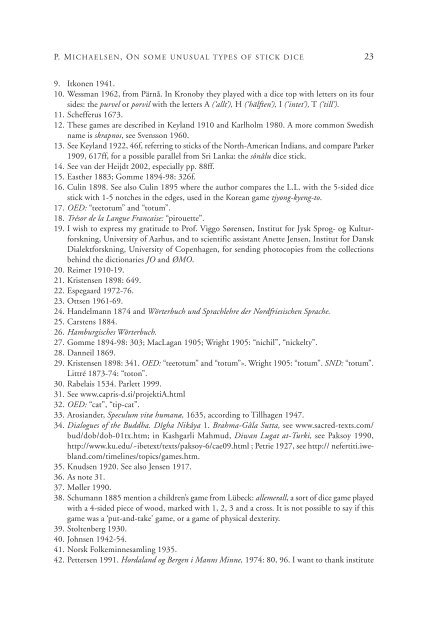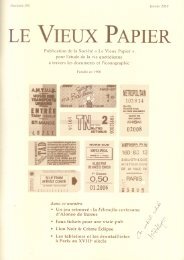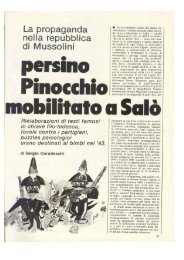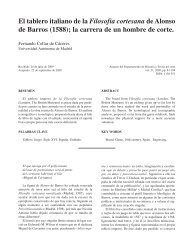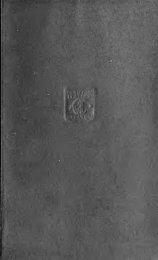Board games from the city of Vijayanagara (Hampi ... - Gioco dell'Oca.
Board games from the city of Vijayanagara (Hampi ... - Gioco dell'Oca.
Board games from the city of Vijayanagara (Hampi ... - Gioco dell'Oca.
You also want an ePaper? Increase the reach of your titles
YUMPU automatically turns print PDFs into web optimized ePapers that Google loves.
P. M ICHAELSEN, ON SOME UNUSUAL TYPES OF STICK DICE 23<br />
9. Itkonen 1941.<br />
10. Wessman 1962, <strong>from</strong> Pärnå. In Kronoby <strong>the</strong>y played with a dice top with letters on its four<br />
sides: <strong>the</strong> purvel or porvil with <strong>the</strong> letters A (‘allt’), H (‘hälften’), I (‘intet’), T (‘till’).<br />
11. Schefferus 1673.<br />
12. These <strong>games</strong> are described in Keyland 1910 and Karlholm 1980. A more common Swedish<br />
name is skrapnos, see Svensson 1960.<br />
13. See Keyland 1922, 46f, referring to sticks <strong>of</strong> <strong>the</strong> North-American Indians, and compare Parker<br />
1909, 617ff, for a possible parallel <strong>from</strong> Sri Lanka: <strong>the</strong> sônâlu dice stick.<br />
14. See van der Heijdt 2002, especially pp. 88ff.<br />
15. Eas<strong>the</strong>r 1883; Gomme 1894-98: 326f.<br />
16. Culin 1898. See also Culin 1895 where <strong>the</strong> author compares <strong>the</strong> L.L. with <strong>the</strong> 5-sided dice<br />
stick with 1-5 notches in <strong>the</strong> edges, used in <strong>the</strong> Korean game tjyong-kyeng-to.<br />
17. OED: “teetotum” and “totum”.<br />
18. Trésor de la Langue Francaise: “pirouette”.<br />
19. I wish to express my gratitude to Pr<strong>of</strong>. Viggo Sørensen, Institut for Jysk Sprog- og Kulturforskning,<br />
University <strong>of</strong> Aarhus, and to scientific assistant Anette Jensen, Institut for Dansk<br />
Dialektforskning, University <strong>of</strong> Copenhagen, for sending photocopies <strong>from</strong> <strong>the</strong> collections<br />
behind <strong>the</strong> dictionaries JO and ØMO.<br />
20. Reimer 1910-19.<br />
21. Kristensen 1898: 649.<br />
22. Espegaard 1972-76.<br />
23. Ottsen 1961-69.<br />
24. Handelmann 1874 and Wörterbuch und Sprachlehre der Nordfriesischen Sprache.<br />
25. Carstens 1884.<br />
26. Hamburgisches Wörterbuch.<br />
27. Gomme 1894-98: 303; MacLagan 1905; Wright 1905: “nichil”, “nickelty”.<br />
28. Danneil 1869.<br />
29. Kristensen 1898: 341. OED: “teetotum” and “totum”». Wright 1905: “totum”. SND: “totum”.<br />
Littré 1873-74: “toton”.<br />
30. Rabelais 1534. Parlett 1999.<br />
31. See www.capris-d.si/projektiA.html<br />
32. OED: “cat”, “tip-cat”.<br />
33. Arosiander, Speculum vitæ humanæ, 1635, according to Tillhagen 1947.<br />
34. Dialogues <strong>of</strong> <strong>the</strong> Buddha. Dîgha Nikâya 1. Brahma-Gâla Sutta, see www.sacred-texts.com/<br />
bud/dob/dob-01tx.htm; in Kashgarli Mahmud, Diwan Lugat at-Turki, see Paksoy 1990,<br />
http://www.ku.edu/~ibetext/texts/paksoy-6/cae09.html ; Petrie 1927, see http:// nefertiti.iwebland.com/timelines/topics/<strong>games</strong>.htm.<br />
35. Knudsen 1920. See also Jensen 1917.<br />
36. As note 31.<br />
37. Møller 1990.<br />
38. Schumann 1885 mention a children’s game <strong>from</strong> Lübeck: allemerall, a sort <strong>of</strong> dice game played<br />
with a 4-sided piece <strong>of</strong> wood, marked with 1, 2, 3 and a cross. It is not possible to say if this<br />
game was a ‘put-and-take’ game, or a game <strong>of</strong> physical dexterity.<br />
39. Stoltenberg 1930.<br />
40. Johnsen 1942-54.<br />
41. Norsk Folkeminnesamling 1935.<br />
42. Pettersen 1991. Hordaland og Bergen i Manns Minne, 1974: 80, 96. I want to thank institute


